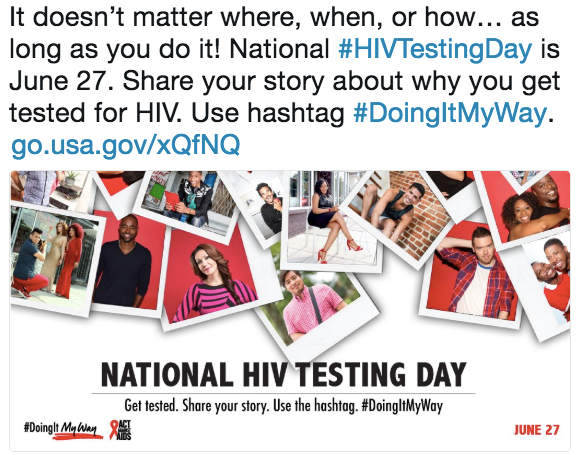Why Aren't High-Risk Patients Being Offered HIV Tests?
New study reports that many individuals with a higher risk for HIV are not being offered an HIV test by their health care provider.
Today, Wednesday, June 27, is National HIV Testing Day. This day was created to encourage everyone to get tested for HIV, learn their status, and subsequently get linked to care and treatment, if necessary. The theme for this year is “Doing it my way, Testing for HIV,” reminding individuals that, “it doesn’t matter where, when, or how… as long as you do it!” (see tweet)
This theme can also be carried over for health care providers, reminding them to share this message with their patients; however, the results of a new study suggest that paradoxically, providers are not recommending testing to some of their patients who are at higher risk of infection, such as active gay and bisexual men.
Current CDC recommendations for HIV testing suggest that all individuals aged 13 to 64 are screened for HIV at least once. The CDC advises that those who are at higher risk of infection may benefit from more frequent testing (every 3 to 6 months).
To explore HIV testing rates in higher risk patients, investigators from the CDC analyzed behavioral data from high-risk populations in 19 cities with high HIV burden contained in the CDC’s National HIV Behavioral Surveillance (NBHS). The investigators focused on 2 populations: men who have sex with men (MSM) and people who inject drugs (PWID).
The MSM population was recruited through venue-based sampling in 2014, and the PWID population was recruited using respondent-driven sampling in 2012 and 2015; all of the participants were 18 and older. A total of 9,105 MSM and 19,357 PWID were recruited.
Behavioral data was captured through anonymous interviews. Participants reported if they had received an HIV test, visited a health care provider, or been offered an HIV test by a health care provider in the past year. Furthermore, participants reported if they were aware or unaware of their HIV status.
The interviews were followed by an HIV test.
The HIV test results indicated that 2002 MSM (22%) and 1589 PWID (8%) were positive for HIV. From this population, 151 MSM (8%) and 184 PWID (12%) were unaware of their HIV status.
Furthermore, 67 MSM and 242 PWID who were unaware of their HIV status reported not receiving an HIV test in the past year.
Members of both groups who were unaware of their HIV infection reported missed opportunities for earlier diagnosis. Approximately 35 (52%) of MSM and 64 (45%) of PWID who tested positive for HIV following the interview had not received an HIV test in the past year and reported not being offered HIV testing by any clinician during health care visits. Therefore, the researchers concluded that many HIV infections could have been diagnosed sooner if HIV testing were offered more frequently.
A limitation of the study is the use of self-reported data and the possibility that clinician visits or HIV testing may not have been reported accurately due to inaccurate recall.
Despite these limitations, the investigators concluded that “eliminating missed opportunities for testing and diagnosis in health care settings may reduce HIV transmission especially among high-risk groups.” It is estimated that about 15% of individuals who are infected with HIV are unaware of their status, and by offering HIV tests to increase the likelihood that an individual knows their status, health care providers can ensure they receive treatment much sooner and decrease the likelihood that they will transmit the virus to another individual.

